

20022_03_s.pdf (application/pdf Object) Kabwe 1. Searching for metal ore deposits in the limestone caves of Kabwe, Zambia, Swiss miner Tom Zwiglaar is credited with finding the first early human fossil ever to be discovered in Africa.

When Kabwe (also known as Broken Hill) was sent to Arthur Smith Woodward, Woodward assigned the specimen to a new species: Homo rhodesiensis. Today, most scientists assign Kabwe to Homo heidelbergensis. Missing DNA helps make us human. A new study demonstrates that specific traits that distinguish humans from their closest living relatives -- chimpanzees, with whom we share 96 percent of our DNA -- can be attributed to the loss of chunks of DNA that control when and where certain genes are turned on.
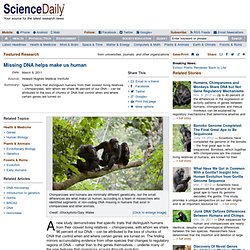
The finding mirrors accumulating evidence from other species that changes to regulatory regions of DNA -- rather than to the genes themselves -- underlie many of the new features that organisms acquire through evolution. Seeking specific genetic changes that might be responsible for the evolution of uniquely human traits, Howard Hughes Medical Institute investigator David Kingsley and colleagues at Stanford University scanned the human genome for features that set us apart from other mammals. The team found 510 segments that are present in chimps and other animals but missing from the human genome.
Hominidae. The Hominidae (/hɒˈmɪnɨdiː/; also known as great apes[notes 1]) form a taxonomic family of primates, including four extant genera:

Homininae. Homininae is a subfamily of Hominidae that includes humans, gorillas, chimpanzees, bonobos and some extinct relatives; it comprises all hominids that arose after the split from orangutans (Ponginae).
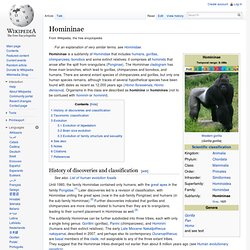
The Homininae cladogram has three main branches, which lead to gorillas, chimpanzees and bonobos, and humans. There are several extant species of chimpanzees and gorillas, but only one human species remains, although traces of several hypothetical species have been found with dates as recent as 12,000 years ago (Homo floresiensis, Homo denisova). Organisms in this class are described as hominine or hominines (not to be confused with hominin or hominini). Scientists discover hominid cranium in Ethiopia. Last modified: Monday, March 27, 2006 FOR IMMEDIATE RELEASE March 27, 2006 BLOOMINGTON, Ind. -- A team of scientists conducting palaeoanthropological field research at Gona, in the Afar Administrative State of Ethiopia, have discovered a significantly complete cranium of a human ancestor estimated to be Middle Pleistocene in age.
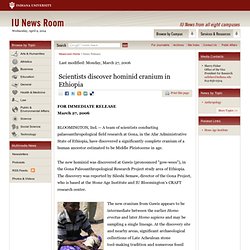
The new hominid was discovered at Gawis (pronounced "gow-wees"), in the Gona Paleoanthropological Research Project study area of Ethiopia. The discovery was reported by Sileshi Semaw, director of the Gona Project, who is based at the Stone Age Institute and IU Bloomington's CRAFT research center. Scientists have reported finding a nearly complete cranium of a human ancestor estimated to be Middle Pleistocene in age. Print-Quality Photo. Homo habilis. Homo habilis (also Australopithecus habilis) is a species of the Hominini tribe, which lived from approximately 2.33 to 1.44 million years ago, during the Gelasian Pleistocene period.[1] While there has been scholarly controversy regarding its placement in the genus Homo rather than the genus Australopithecus,[2][3] its brain size has been shown to range from 550 cm3 to 687 cm3, rather than from 363 cm3 to 600 cm3 as formerly thought.[3][4] These more recent findings concerning brain size favor its traditional placement in the genus Homo, as does the need for the genus to be monophyletic if H. habilis is indeed the common ancestor.
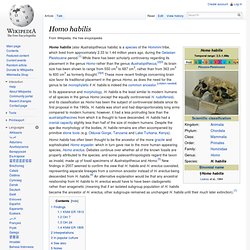
[citation needed] Homo habilis has often been thought to be the ancestor of the more gracile and sophisticated Homo ergaster, which in turn gave rise to the more human-appearing species, Homo erectus. Findings[edit] KNM ER 1813[edit] OH 7[edit] Homo rudolfensis. Homo rudolfensis (also Australopithecus rudolfensis) is an extinct species of the Hominini tribe known only through a handful of representative fossils, the first of which was discovered by Bernard Ngeneo, a member of a team led by anthropologist Richard Leakey and zoologist Meave Leakey in 1972, at Koobi Fora on the east side of Lake Rudolf (now Lake Turkana) in Kenya.

On 8 August 2012, a team led by Meave Leakey announced the discovery of a face and two jawbones belonging to H. rudolfensis. Homo gautengensis. Homo gautengensis is a hominin species proposed by biological anthropologist Darren Curnoe in 2010.
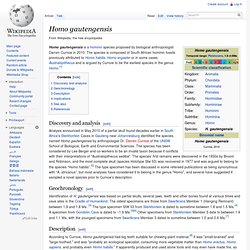
The species is composed of South African hominin fossils previously attributed to Homo habilis, Homo ergaster or in some cases Australopithecus and is argued by Curnoe to be the earliest species in the genus Homo.[1] Discovery and analysis[edit] Analysis announced in May 2010 of a partial skull found decades earlier in South Africa's Sterkfontein Caves in Gauteng near Johannesburg identified the species, named Homo gautengensis by anthropologist Dr.
Darren Curnoe of the UNSW School of Biological, Earth and Environmental Sciences. The species has been considered by Lee Berger and co-workers to be an invalid taxon because it conflicts with their interpretations of "Australopithecus sediba". Geochronology[edit] Identification of H. gautengensis was based on partial skulls, several jaws, teeth and other bones found at various times and cave sites in the Cradle of Humankind. One metre-tall human challenges history of evolution. Australian and Indonesian scientists have identified a new and completely unexpected species of human.

It was only a metre high, had a small brain but a distinctly human face. It made delicate stone tools and it shared the planet with Homo sapiens at least 18,000 years ago. New human species found in Siberia. The remains of a little finger discovered in a cave in the mountains of southern Siberia belong to a previously unknown human ancestor, scientists said today.
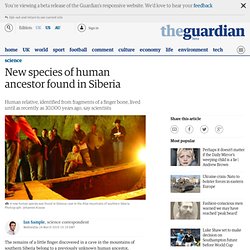
The finding suggests an undocumented human species lived alongside Neanderthals and early modern humans in parts of Asia as recently as 30,000 years ago. If confirmed, it would be the first time a new human ancestor has been identified since the discovery of Homo floresiensis, the diminutive "hobbits" that lived on the Indonesian island of Flores until 13,000 years ago. Fragments of the finger bone were recovered from Denisova cave in the Altai mountain range that straddles Russia, Mongolia, China and Kazakhstan.
The cave was occupied by humans for 125,000 years and a variety of stone tools and bones have been recovered. The size of the bone has led scientists to believe it came from a child, aged between five and seven, though they are unable to say whether it was male or female. Neanderthal genomics and the evolution of modern humans. James P. Noonan + Author Affiliations Abstract Humans possess unique physical and cognitive characteristics relative to other primates. Mapping a Cave Fish Genome: Polygenic Systems and Regressive Evolution. + Author Affiliations Address correspondence to Richard Borowsky at the address above or e-mail: rb4@scires.nyu.edu. Received November 17, 2000. Accepted December 7, 2001. Abstract We used random amplified polymorphic DNA (RAPD) fingerprinting to generate anonymous DNA markers in the fish Astyanax mexicanus, a species with both surface and cave populations.
Geologic time scale. The geologic time scale (GTS) is a system of chronological measurement that relates stratigraphy to time, and is used by geologists, paleontologists, and other earth scientists to describe the timing and relationships between events that have occurred throughout Earth's history. The table of geologic time spans presented here agrees with the nomenclature, dates and standard color codes set forth by the International Commission on Stratigraphy. Evidence from radiometric dating indicates that the Earth is about 4.54 billion years old. The geology or deep time of Earth's past has been organized into various units according to events which took place in each period. Different spans of time on the GTS are usually delimited by changes in the composition of strata which correspond to them, indicating major geological or paleontological events, such as mass extinctions.